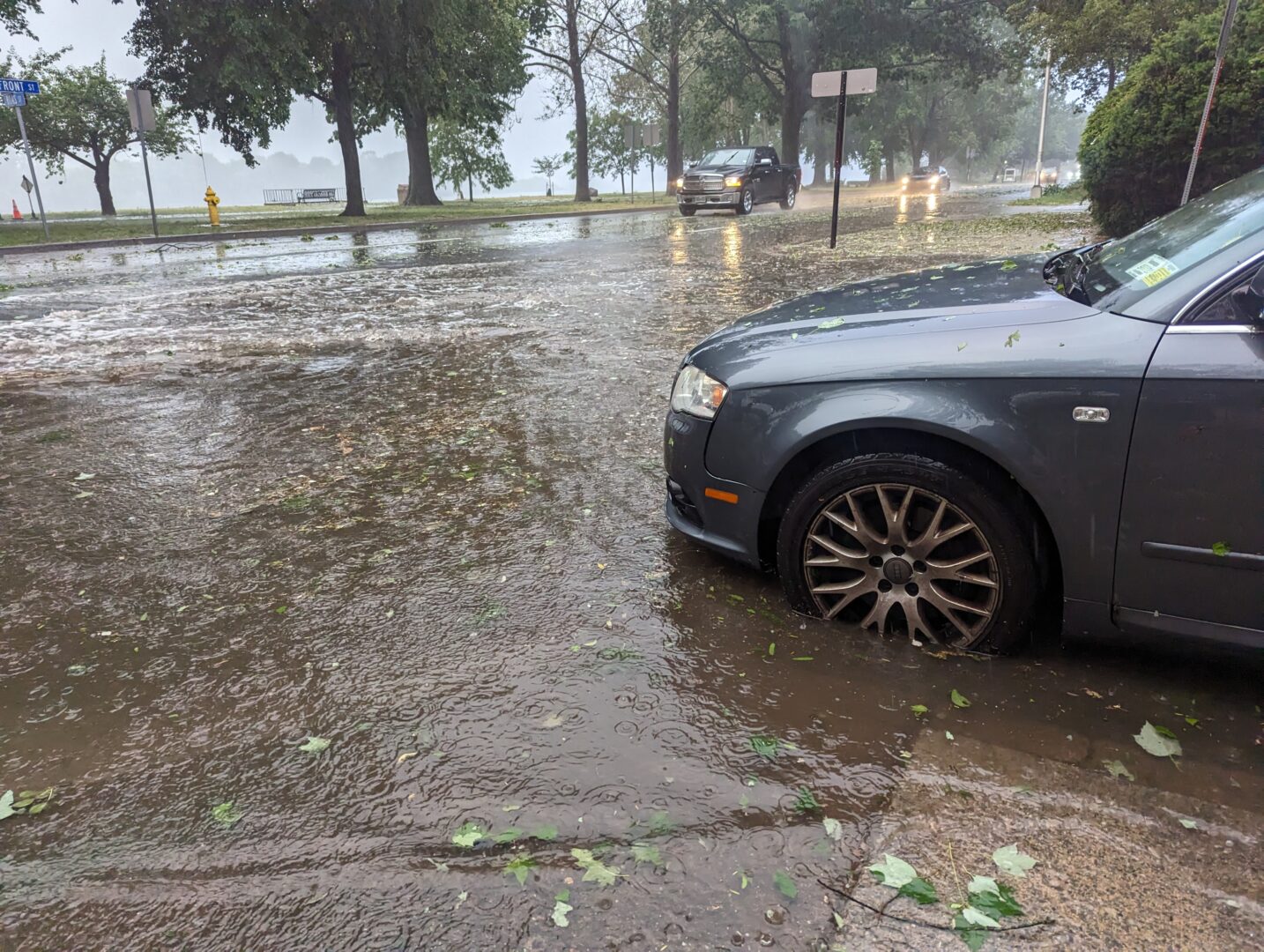
A thunderstorm in Harrisburg on June 3, 2023 caused minor flooding on Front Street at Boas Street.
Rachel McDevitt / StateImpact Pennsylvania


A thunderstorm in Harrisburg on June 3, 2023 caused minor flooding on Front Street at Boas Street.
Rachel McDevitt / StateImpact Pennsylvania

Rachel McDevitt / StateImpact Pennsylvania
A thunderstorm in Harrisburg on June 3, 2023 caused minor flooding on Front Street at Boas Street.
Central Pennsylvania communities have seen a number of severe floods over the past few years. Climate change is making these events more likely across the state.
Engineers at Penn State are trying to figure out the relationship between flooding in Middletown and rainfall rates, soil moisture and streams that were paved over decades ago.
Beyond the physical impacts, a team of researchers is also looking into how floods have affected people in the area.
“These kind of hidden environmental day-to-day impacts really place a lot of stress on peoples’ everyday lives and that can have all sorts of consequences that we should pay attention to,” said Anthony Bak Buccitelli, director of the Pennsylvania Center for Folklore at Penn State Harrisburg.
Buccitelli said his team is documenting stories from people in Middletown about flooding, with a focus on personal, family, and community impacts. They’re collecting information on how people adapt after flooding, how they think about responsibility or blame, and support they got from the community.
Buccitelli expects to continue collecting stories for about a year before producing a report.
A recent, separate study found that environmental disasters associated with climate change can have a big effect on teens’ well-being and academic performance.
The paper, published recently in the journal Population Research and Policy Review, looks at data from a survey done over 15 years with more that 1,700 children in Peru.
The paper was led by Carolyn Reyes while she completed a doctoral degree at Penn State.
Buccitelli said his ethnographic research is different from Reyes’ study, but they are both interested in the hidden impacts people experience from certain events that might not rise to the level of a disaster.
He said, even as they hear about negative effects, they are finding that people really appreciate a community coming together in hard times.
“While it is important to make sure we’re really attuned to the negative outcomes…we should also focus on the positive, as well, and understand how local community, or family or social networks play a really important role and meaningful role in helping people to deal with adverse situations,” Buccitelli said.
Reyes’s work used data from the Young Lives Longitudinal Survey, which collected information on test scores, food security and health, how much time kids spent studying and doing household chores, and whether families had experienced some kind of shock. Those include a parent’s job loss, death of a relative, and natural disasters like a flood or drought.
The study found that children who experience a higher number of shocks across their lifetime are more likely to have significantly lower reading and vocabulary scores, and a lower chance of always having enough to eat.
Recent shocks appeared to have a greater effect. The study says 15-year-olds who experienced a shock in the past few years were more likely to have lower test scores, be less food secure, have poorer health and spend more time on household chores. The authors said earlier research has shown that older children are more likely to be aware of issues at home and more likely to help their parents or even leave school for work.
“The types of shocks that consistently had the strongest and significant negative effects on young people were environmental shocks,” Reyes said.
As Earth warms, environmental disasters are becoming more intense and more likely.
Though this research focused on Peru, Reyes said there are takeaways for countries like the U.S.
“Households and families cannot control that these shocks happen to them, they’re going to increasingly happen to them and I think there is a role for the government to play in creating policies that really help people stave off the worst impacts,” Reyes said.
Emily Hannum, a professor of sociology and education at the University of Pennsylvania who was not involved in the study, said the research looks to be carefully-executed.
She said the paper is honest about its limitations – for example, shocks are self-reported, the Young Lives survey oversamples economically disadvantaged youth, and it does not include data on family shocks while a child is in-utero or in the first 6-18 months of life.
Hannum, whose research looks at climate risk, pollution, and children’s welfare in China, said the attention to timing of shocks and how they affect teens is striking.
“In the United States and elsewhere, building up knowledge about how environmental hazards, along with economic shocks, affect children is a timely and important task. This work adds a significant empirical case,” Hannum said.
StateImpact Pennsylvania is a collaboration among WITF, WHYY, and the Allegheny Front. Reporters Reid Frazier, Rachel McDevitt and Susan Phillips cover the commonwealth’s energy economy. Read their reports on this site, and hear them on public radio stations across Pennsylvania.
(listed by story count)
StateImpact Pennsylvania is a collaboration among WITF, WHYY, and the Allegheny Front. Reporters Reid Frazier, Rachel McDevitt and Susan Phillips cover the commonwealth’s energy economy. Read their reports on this site, and hear them on public radio stations across Pennsylvania.
Climate Solutions, a collaboration of news organizations, educational institutions and a theater company, uses engagement, education and storytelling to help central Pennsylvanians toward climate change literacy, resilience and adaptation. Our work will amplify how people are finding solutions to the challenges presented by a warming world.